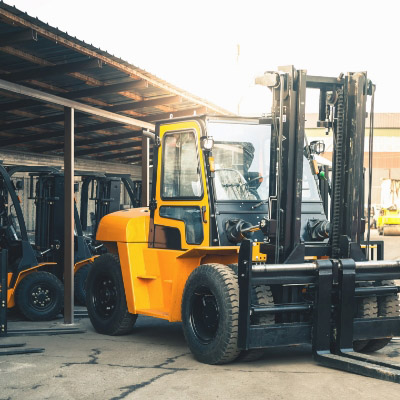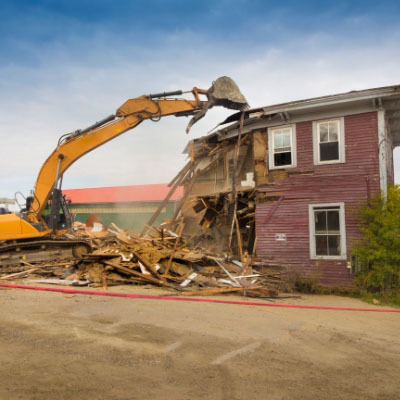How to Use a Skid Steer

Published December 19, 2024
Skid steers are compact construction machines that can play big roles on the job site. Also called skid-steer loaders or skid loaders, they’re commonly used on construction sites and residential properties for digging, excavation and other jobs unsuitable for larger equipment.
Skid steers can be simple to operate with the right training and enough practice. This guide reviews how to use a skid steer, as well as the types of skid steer attachments and maintenance.
Table of Contents
Getting Started With a Skid Steer
Operation Techniques for Skid Steer Use
Types of Skid Steer Attachments
How to Maintain a Skid Steer
More Tools. More Products. More Perks.
Getting Started With a Skid Steer

Before using a skid steer, complete all necessary training. OSHA regulations require training of all loader and earth-moving equipment operators.
As with many large equipment rental decisions, choose a skid steer based on terrain type and other job demands. Wheeled skid steers are better for flat or hard surfaces. Tracked skid steers, also called track loaders, have tracks or treads and are preferable for uneven terrain or muddy conditions.
- Choose skid steers with high hydraulic flow if you plan to use multiple attachments.
- Choose large skid steers with high horsepower and torque for moving rocks and other heavy loads.
- Vertical lift skid steers are better for loading trucks and raising heavy loads over the height of the skid steer.
- Radial lift skid steers are better for digging, grading and other ground-level tasks.
Consider these tips when you operate a skid steer for the first time:
- Don’t jump into the cabin right away. Read the manual and familiarize yourself with all parts of the skid steer before getting into the cabin. Safely operating heavy equipment is critical. Be aware of potentially hazardous situations on your worksite to make sure you keep the equipment – and yourself – out of harm’s way.
- Focus on the essentials. Many of the controls in the cabin are either for advanced uses or for other attachments like augers. For simpler projects like moving dirt from one pile to another, all you need are the joysticks.
- Set aside more time than you think. Take time to practice moving the machine back and forth and rolling and curling the bucket to get comfortable with how the machine reacts to your control. Build in buffer time to familiarize yourself with the equipment and its capabilities to make it easier once you start working.
- Start simple. When you first rent a skid steer, it’s a good idea to start with a simple task until you’re comfortable with the equipment and its controls. You may not want to rent a skid steer for the first time when you’re trying to pick up huge trees or grade steep roads.
Operation Techniques for Skid Steer Use

The following are the basic operational techniques for using a skid steer.
Follow these steps to enter and turn on the skid steer.
- Observe all safety procedures when entering the skid steer, including holding the grab bars and using the steps.
- Sit in the operator’s seat, then lower the safety bar and buckle the safety belt.
- Insert and turn the ignition key or press the start button.
- Release the parking brake.
- After starting the skid steer, allow it to idle for a few minutes to check for unusual noises.
Most skid steers have the same types of controls. Skid steer controls with the International Standardization Organization (ISO) pattern include the following:
- Starting controls, usually either a key ignition or keyless starter button.
- Parking lockout system, often including a safety belt and an overhead safety lock that must be in place before releasing the parking brake.
- Left-side joysticks or steering levers, which control driving.
- Right-side joysticks or steering levers, which control the bucket.
How to use an ISO pattern skid steer’s left-hand joystick:
- Pushing forward moves the skid steer forward.
- Pulling back moves the skid steer backward.
- Tilting left turns the skid steer left.
- Tilting right turns the skid steer right.
How to use an ISO pattern skid steer’s right-hand joystick:
- Pushing forward lowers the boom.
- Pulling back raises the boom.
- Tilting left closes the bucket.
- Tilting right opens the bucket.
Other skid steer controls have a standard pattern with levers that control the driving function and pedals that control the bucket.
Follow these steps to turn off the skid steer after use:
- Park the skid steer on a flat surface.
- Lower the bucket or attachment until it sits flat on the ground.
- Set the parking brake.
- Press the stop button or turn and remove the ignition key.
- Raise the safety bar, unbuckle the safety belt and exit using the handles and steps.
Observe these tips for safely using a skid steer.
- Do not operate a skid steer on unstable ground.
- Avoid turning, loading or unloading the skid steer on uneven ground to prevent tipping.
- Drive the skid steer vertically up and down slopes. Driving horizontally across a slope can risk tipping the skid steer over.
- Keep the bucket at the lowest possible position when turning or traveling.
Pro Tip: As a safety precaution, carry loads close to the ground, elevated enough to clear obstacles. Loads carried too high may cause the skid steer to fall over.
Types of Skid Steer Attachments

Skid steers are designed to be used with different attachments for such jobs as construction, demolition, material handling and more. Before skid steer use, make sure you have the right size attachment for the needs of the job.
- Buckets carry, transport or dig through various materials.
- Box blades are specialized buckets for grading and leveling.
- Augers drill holes for landscaping, construction and agricultural jobs.
- Forks lift and transport logs, pallets and other items.
- Trenchers have chains and teeth for digging holes or trenches in various types of soil for plumbing, drainage or electrical jobs.
- Concrete mixers transport and mix concrete on-site.
- Hydraulic hammers break concrete, rock and other hard materials primarily for demolition jobs.
- Snow blades are used to plow or removing snow.
Pro Tip: Consider mini skid steer rental for jobs in tighter surroundings, like small residential yards.
How to Maintain a Skid Steer

Skid steer maintenance can be relatively inexpensive but will enhance the performance and extend the life of a skid steer.
- Make visual inspections before every skid steer shift, checking for leaks around hoses and other worn or damaged parts.
- Check fluid levels, including fuel, coolant, engine oil and hydraulic oil.
- Confirm tire pressure or track tension are at recommended levels.
- Clean the skid steer after use, especially to ensure that dirt or dust have not contaminated the engine compartment.
- Perform regular maintenance after 250, 500 and 1,000 hours of use, including changing engine oil and replacing filters.
More Tools. More Products. More Perks.

Be more competitive and boost your bottom line with Pro Xtra, The Home Depot’s loyalty program built for Pros. Sign up today to access the enhanced Pro Online Experience, built with the online business tools and time-saving features Pros need.
Use our tool and large equipment rental services for access to heavy-duty equipment for construction jobs.





























